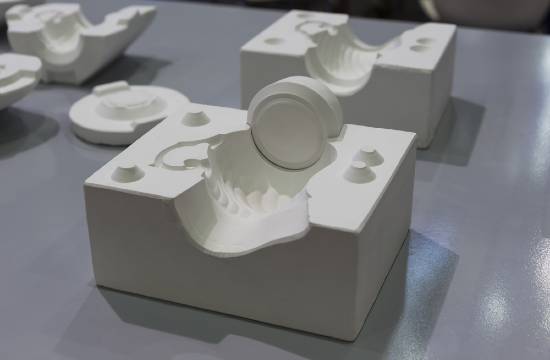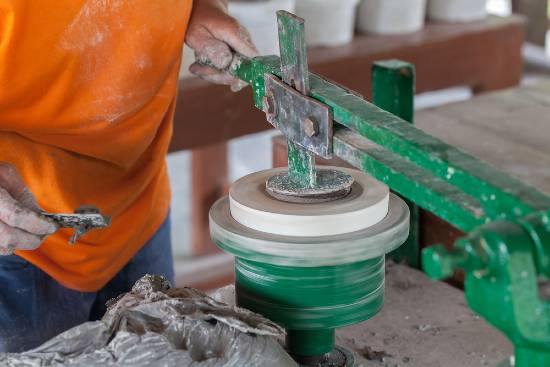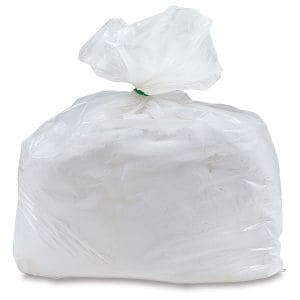Your cart is currently empty!
Pottery Plaster Vs Plaster of Paris – Which to Use?
Published:
Last Updated:

Affiliate Disclaimer
As an affiliate, we may earn a commission from qualifying purchases. We get commissions for purchases made through links on this website from Amazon and other third parties.
Plaster has lots of uses for potters. For example, it can be used, for mold making, casting, and making damp boxes. But there are a lot of different types of plaster. And if you are trying to figure out which one to use, it can be confusing. In particular, you might be wondering about the benefits of Pottery Plaster vs Plaster of Paris. There are some general differences between pottery plaster and Plaster of Paris. These differences can be summed up as follows:
Pottery plaster is harder than Plaster of Paris. So, it is better for casting molds that experience wear and tear. However, Plaster of Paris is usually less expensive and is suitable for low wear and tear items. Also, some makes of Plaster of Paris are as strong as pottery plaster.

However, to make an informed decision between pottery plaster vs Plaster of Paris, it helps to know a little more. So, read on…
How Does Plaster Work?
There are a number of different types of plaster. The main ingredient in each of these types of plaster is calcium sulfate, which is similar to chalk.
Calcium sulfate is a mineral that is mined from the ground and processed. Part of the processing involves grinding it up to a powder and heating it. The heating process is called ‘calcining’. During the heating process, the calcium sulfate loses some of its water content. Once it has become partially dehydrated it is called calcium sulfate ‘hemihydrate’.
In its partially dehydrated state, it becomes usable as an ingredient in plaster. This is because, when it is mixed with water a ‘setting reaction’ takes place. This is a chemical reaction where the water recombines with the calcium sulfate particles. When the calcium sulfate bonds with the water, it changes from hemihydrate to dihydrate.
During the setting reaction, crystals are formed in the mixture of water and calcium sulfate. These crystals are what make the plaster harden. The crystals form a matrix-like structure in the plaster that gives it strength. The crystals also form capillaries in the plaster. These capillaries are tiny microscopic open channels in the plaster that make the hardened plaster porous.
One of the reasons plaster is so handy for potters is that is porous and absorbent. For example, when it’s used as a casting mold, liquid clay (called slip) is poured into the plaster mold. The water from the clay is drawn out of the slip by the pores in the plaster mold. This in turn hardens the slip, turning the liquid clay into greenware pottery.

Different Types of Plaster
Plaster is also referred to as ‘gypsum’. This is because gypsum is another name for calcium sulfate. You will often hear potters and builders referring to gypsum plaster or gypsum molds. This is because the word gypsum and plaster are used interchangeably.
There are different types of gypsum or plaster. Different types of plaster vary in their strength once the plaster has been mixed with water and set. They also vary in how long they take to set and how absorbent they are. In addition to this, they vary in how long it takes them to dry out once they have been used. And how much they expand when they have been rehydrated with water.
All these factors will affect which kind of plaster is suitable for a particular job. Of the various different types of plaster, the two most used by potters are Plaster of Paris and Pottery Plaster. Here are some of the differences between the two…
Pottery Plaster Vs Plaster of Paris
Plaster of Paris is cheaper and more easily available than Pottery Plasters, so let’s take a look at it first…
What is Plaster of Paris?
Plaster of Paris is an umbrella term that is often used to refer to quite a few different types of plaster. This can be a bit confusing, so I will try to tease out these differences.
Plaster of Paris gets its name from its historical origins. The city of Paris rests on a large supply of high-quality gypsum (source). Back in the 17th century, King Louis IV of France demanded that the buildings of Paris were clad with gypsum.
This was because in 1666 the city of London, England was destroyed by the Great Fire of London. Fire tore through the city of London consuming flammable timber buildings. The response in Paris was to protect their flammable timber buildings with a layer of fire-retardant plaster.
Since then, Plaster of Paris has become a term used to refer to various kinds of gypsum.
Different uses of the term ‘Plaster of Paris’.
On the one hand, the term Plaster of Paris is sometimes used to refer to something called ‘beta gypsum’. Broadly speaking, different types of plaster can be divided into two categories. These are ‘beta’ and ‘alpha’ gypsum. This refers to how their ingredients are heated during production.
When calcium sulfate is processed during the manufacture of plaster, it is heated up. This heating process drives out water from the mineral. Sometimes this heating process happens in atmospheric pressure, meaning that the steam is freely allowed to escape. At other times, the gypsum is heated under pressure.
These two processes create plaster with different shaped crystals. When gypsum is heated in a non-pressurized environment, it produces ‘beta gypsum’. The crystals that are formed in beta gypsum are shorter and less organized. When gypsum is heated in a pressurized atmosphere, it makes plaster that forms longer more organized crystal structures. This is called ‘alpha gypsum’.
Because the crystals of alpha gypsum are longer and more organized, alpha gypsum is stronger than beta gypsum.
Some manufacturers and suppliers state that Plaster of Paris is a beta gypsum. As such, Plaster of Paris is often said to be one of the less strong gypsums available.
However, some manufacturers market Plaster of Paris products that are a blend of beta and alpha gypsum. Specialist manufacturers of Plaster of Paris often offer a range of products. These have different blends of beta and alpha gypsum. The different ratios of beta and alpha gypsum will have different properties. Here is an example of a supplier of this kind.
So, although Plaster of Paris is often used to refer to beta gypsum which is less strong, this is not always the case. It can also be used to refer to blended types of plaster that are stronger.
Pottery Plaster Vs Plaster of Paris – The Differences
In the building trade, the term Plaster of Paris is often taken to mean the same thing as Pottery Plaster. Generally, in the world of construction, these terms are used interchangeably to refer to softer plaster suitable for decorative moldings.
This has added to the confusion about different types of plaster. In the world of pottery, Plaster of Paris and Pottery Plaster refer to different types of products with different properties.
What is Pottery Plaster?
Amongst potters, the term Pottery Plaster refers to plaster with a particular composition that makes it very strong.
There are different makers of pottery plaster, but one of the most recommended is USG No. 1 Pottery Plaster. This is also referred to as #1 pottery plaster.
#1 pottery plaster is made from alpha gypsum. This means that it’s made from gypsum that is heated up and semi dehydrated under pressure during production. Because the crystals formed in alpha gypsum are longer and more organized, alpha gypsum is stronger when it set.
The Advantages of Alpha Gypsum:
- Plaster made from alpha gypsum is stronger. This means that it survives the wear and tear of being used for longer. As a result, a case mold can be used for more cycles of production. Typically, a well-made mold can be used around 80 times.
A plaster mold suffers from wear and tear in a few ways. Firstly, there is the wear and tear of general handling, and having clay forms removed. But also, continually absorbing water and then drying the mold out afterward eventually erodes the pores in the plaster.
Molds made from pottery plaster are stronger and can tolerate the rough and tumble of this process. A Plaster of Paris mold that is made mainly from beta gypsum would wear out a lot quicker.
- Pottery plaster is better if you are jiggering and jollying. Jiggers and jollys are both plaster molds. A Jigger is a convex mold that is attached to the wheel head. A slab of clay is flattened onto the mold.
Then a rigid template is held up against the clay as the wheel head turns. The template presses the clay into a particular design shape as the clay spins. It’s a good way of getting consistently shaped pieces and works well for plates, bowls, and dinnerware.
A Jolly works on the same principle, but it’s a concave mold. When using a jolly, the clay is pressed into the plaster mold using a template as the wheel head turns.
Jiggers and jollys need to be made from tough plaster. This is because pressing the clay into them with the template requires some force. As such, a tough pottery plaster made from alpha gypsum is required, rather than the softer Plaster of Paris option.

The Disadvantages of Alpha Gypsum:
Usually, there is a trade-off between strength and porosity. Often plaster is made from alpha gypsum and is stronger, but it is less porous. Because it’s less porous, it takes longer to absorb liquid from clay. It also takes longer for the mold to dry out after it’s been used.
Adding time to the production process is a disadvantage because it makes the process less efficient. This is a concern, particularly for production potters who are making pottery at speed. But it’s also an inconvenience for hobby potters who may not want to wait for their casts to be ready.
However, #1 pottery plaster has the advantage of being both strong and absorbent. USG state that their particular pottery plaster has the advantage of being strong and absorbent because of its ingredients. So, let’s take a look at what #1 pottery plaster is made of….
#1 Pottery Plaster
USG Pottery plaster is made of the following:
- Calcium sulfate hemihydrate
- Potassium sulfate
- Potassium sodium tartrate
It’s said that the potassium sulfate and potassium sodium tartrate in a particular ratio make molds strong and porous too.
So, #1 Pottery plaster has the ideal combination of being strong and porous. This makes it the best choice for slip casting molds. And also for molds like jiggers and jollys that need to withstand wear and tear.
Final Thoughts
Most potters will say that Plaster of Paris is fine if you are making an item with low wear and tear. An example of this would be a damp box. Once you have lined your damp box with plaster, the plaster is protected and unlikely to chip or crack.
An advantage of Plaster of Paris is that it’s cheaper than pottery plaster. So, if you don’t need the additional strength, then Plaster of Paris is fine.
By contrast, if you’re making molds for slip casting, jiggering, and jollying, pottery plaster is best.
You can use Plaster of Paris for molds if you buy it from a specialist plaster supplier. As stated above, some suppliers that specialize in Plaster of Paris use a blend of alpha and beta gypsum. This particular kind of Plaster of Paris is stronger than what you’d buy in a hardware store.
Likewise, if you’re making a mold that will only be used a few times Plaster of Paris should be fine. I have made molds out of Plaster of Paris that have worked well. However, these were sculpture molds and were only used a few times.
I’ve also cast sculptures out of Plaster of Paris and this worked well. Because it’s decorative rather than functional, it doesn’t need to be that strong. Also, the softness of the plaster makes it easier to tidy up seams and blemishes afterward.
So, weighing up the advantages of pottery plaster vs Plaster of Paris needs to take into consideration a few factors. If you need your plaster to be strong and durable then pottery plaster is worth the extra expense. But for low wear and tear items, Plaster of Paris will be suitable.





